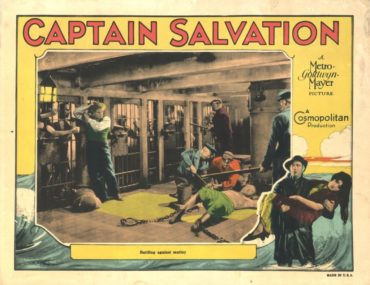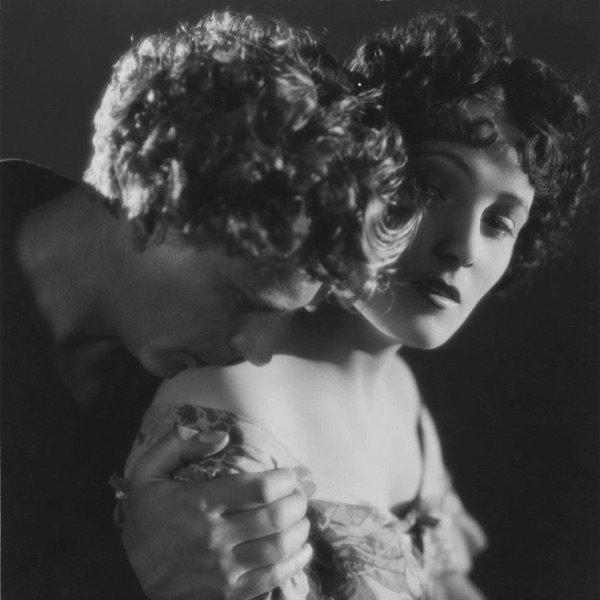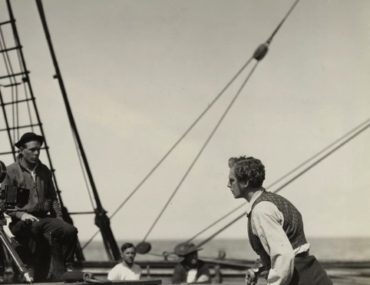CAPTAIN SALVATION
John S. Robertson (US 1927)
Score composed and conducted by: Philip Carli
Performed live by: Orchestra San Marco, Pordenone

The most extraordinary moment in Captain Salvation occurs early on, when divinity student Anson Campbell (Lars Hanson) rescues prostitute Bess Morgan (Pauline Starke) from the cruelty of his puritanical town following a shipwreck. He brings her back to his home and gently revives her, but she’s suspicious of his motives. “My step-pa helped me once,” she scornfully tells him. “A good thing the baby died!” Then she repeats herself: “Do you understand – damn good thing the baby died!”
The lines still have the power to shock – this is an M-G-M film from 1927, after all. French critic Jean George Auriol found the words so strong that he quotes them in an article about the power of well-written intertitles over dialogue in sound films (La Revue du Cinéma, 15 October 1929). The film’s strengths go far beyond its frankness, which makes its relative obscurity perplexing, especially given the praise heaped on it upon its release. Variety’s Alfred Greason (“Rush.”) wrote, “in details of settings, composition of backgrounds, delicacy of photographic effect, the film is flawless.” The Philadelphia Tribune was even more effusive: “one of the finest dramatic achievements of the year. It is a photoplay that will cause your brain to tingle and your heart to throb.”
M-G-M purchased the rights to Frederick William Wallace’s 1925 novel within months of its publication, turning it over to Kate Corbaley for the adaptation and Lorna Moon for the scenario. These treatments, now housed at the Margaret Herrick Library in Los Angeles, differ significantly from the book, but producer Hunt Stromberg wasn’t happy with their direction and gave script duties to Jack Cunningham, who had recently completed The Black Pirate. Cunningham’s initial note to Stromberg, on 27 October 1926, lays out his ideas: “we will find our best method of attack along the lines of a character study, heightening what is now narrative to drama….” Two months and nine treatments later, Stromberg stepped in with razor-sharp discernment, suggesting Cunningham spend more time developing the characters’ psychology so audience sympathy falls squarely with both Anson and Bess. Her lines about the dead baby only appear in the final script, submitted in May 1927, and may come from title writer John Colton, best known for the stage adaptation of W. Somerset Maugham’s novel Rain. Also late in the writing stage was the addition of her feminist cry, “Ain’t I a right to my body?” when menaced by Ernest Torrence’s sleazy ship captain.
Reginald Barker was first attached as director, and then George Hill, before John S. Robertson (1878-1964) was hired in December 1926, reportedly on the strength of his work on Annie Laurie. Lars Hanson appears to have been cast in early February 1927 (the same month filming started), fulfilling Cunningham’s wise advice to Stromberg, “we must be assured that ‘Captain Salvation’ is to be handled by an actor who is personably as well as histrionically capable of carrying seven reels of picture.” They certainly found their man. M-G-M clearly wanted this to be a prestige production, assigning a crew of 75 and hiring the Santa Clara, an 1876 four-masted ship, for the scenes at sea. Cedric Gibbons and Leo E. Kuter designed evocative sets for the seaside town of Maple Harbor, Massachusetts, and locations were filmed on Catalina Island. Cinematographer William Daniels, Garbo’s cameraman, worked his magic – there’s a nighttime lighting scene that recalls Flesh and the Devil – and Millard K. Wilson, assistant director on Victor Sjöström’s He Who Gets Slapped, fulfilled the same role for Robertson.
The Scandinavian connection isn’t casual, and it was Philip Carli who first brought to my attention Sjöström’s striking influence on Captain Salvation. Atmospheric coastal scenes boast meticulous attention to effects of light, and the sea’s presence is beautifully calibrated to elide with the emotional states of the characters. Robertson was unmistakably inspired in how he plays with distance and foreground, and Daniels’ camerawork exhibits a virtuosity within the ship’s rigging that’s as exciting as it is beautiful. The film’s formal similarities to Scandinavian cinema are so pronounced that a 1931 article about Hanson in Les Dimanches de la Femme (11 January) claims Captain Salvation was the actor’s last Swedish film before coming to the United States.
Thematically, the film pulls off the miracle of being intelligently religious without preachiness or sentiment. Anson loses his faith because of the bigoted people around him, and regains it thanks to prostitute Bess, whose goodness remains intact despite circumstances. Variety’s Greason was clearly moved in his review, noting, “This is the first picture that has come to this writer’s attention in which formal religion is vindicated as a high dramatic motif…. What it will do is to create good will throughout the country among those people who have been frankly hostile to ‘movies’ because of a tendency, real or imagined, to deal frivolously with certain conventions of society.”
The Giornate is deeply grateful for the exceptional assistance of Patrick Loughney and the Packard Humanities Institute, who went out of their way to locate a print and ensure it was ready in time for the festival.
Jay Weissberg

regia/dir: John S. Robertson.
scen: Jack Cunningham, dal romanzo di/from the novel by Frederick William Wallace (1925).
did/titles: John Colton.
photog: William Daniels.
mont/ed: William Hamilton.
scg/des: Cedric Gibbons, Leo E. Kuter.
cost: André-ani.
asst dir: Millard K. Wilson.
stills photog: Ruth Harriet Louise.
cast: Lars Hanson (Anson Campbell), Marceline Day (Mary Phillips), Pauline Starke (Bess Morgan), Ernest Torrence (Captain), George Fawcett (Zeke Crosby), Sam De Grasse (Peter Campbell), Jay Hunt (Nathan Phillips), Eugenie Besserer (Mrs. Buxom), Eugenie Forde (Mrs. Bellows), Flora Finch (Mrs. Snifty), James Marcus (vecchio lupo di mare/Old Sea Salt).
prod: Hunt Stromberg, Cosmopolitan Productions.
dist: M-G-M.
uscita/rel: 14.05.1927.
copia/copy: 35mm, 7342 ft., 89′ (22 fps); did./titles: ENG.
fonte/source: Warner Bros., Burbank, CA. / Packard Humanities Institute, Santa Clarita, CA.



 Italiano
Italiano